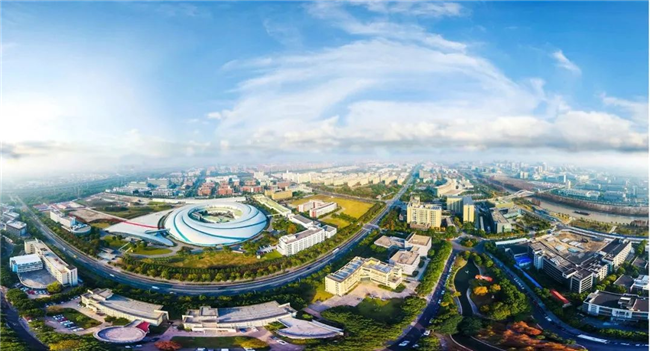Zhangjiang zone: A hub for the country's top scientific research institutions

The Shanghai Synchrotron Radiation Facility, located in Zhangjiang, is the largest scientific device and public experimental platform in China. [Photo/WeChat account: pdnews]
The Zhangjiang National Innovation Demonstration Zone in East China's Shanghai was approved by the State Council in 2011, and after 10 years of development, a comprehensive national sci-tech innovation center is starting to take shape in the zone, according to a local news report.
The zone currently houses 14 mega science projects that are either in operation or under construction. There are 330 national research and development (R&D) institutions in the zone, such as the Tsung-Dao Lee Institute and the National Center for Protein Science (Shanghai).

The Zhangjiang National Innovation Demonstration Zone currently houses 330 national R&D institutions such as the Tsung-Dao Lee Institute. [Photo/WeChat account: pdnews]
Currently, the zone is beefing up efforts to enhance innovation capabilities and major technology breakthroughs and promote the construction of clusters for key science and technology infrastructure in a bid to push forward the revitalization of national key industries and the growth of strategic emerging industries.
The Shanghai Synchrotron Radiation Facility (SSRF), located in Zhangjiang, is the largest scientific device and public experimental platform in China. The facility, the first large science project jointly invested by the central government and the municipal government of Shanghai, is involved in pioneering scientific research in various fields, including life sciences, new materials, physics, chemistry, environmental sciences, and archaeology. It is by far the largest scientific project in China.
It has already clocked over 340,000 hours in experiments conducted since it was put into service in 2009. With the help of SSRF, a number of international high-level R&D scientific research achievements have been made, including significant progress toward elucidating the structures of human glucose transporters thanks to Yan Ning, a biologist at Tsinghua University, and her laboratory.
The radiation facility is one major part of a cluster of large-scale radiation projects in Zhangjiang, where one of the country's three comprehensive national science centers is based. Seven other major projects, such as beam line stations, hard X-ray free-electron laser equipment, and soft X-ray free-electron laser equipment, form a cluster with a total investment of around 13.8 billion yuan ($2.11 billion), 71.2 percent of which will come from the municipal government of Shanghai. All eight projects will be completed and operational by 2025.
At the same time, the zone is playing an important role in improving core technologies. Since the COVID-19 pandemic outbreak last year, it has offered great support for the country in scientific research and disease control and treatment in the fight against the pandemic. The SSRF and the National Center for Protein Science (Shanghai) actively responded and opened green channels for the scientific research of COVID-19.
The zone also has benefited from the cluster development of new types of R&D institutions in recent years. Local authorities said that, supported by institutional innovation, new types of R&D institutions have broken down barriers that prevent the integration and collaborative innovation of industries, universities, and research institutes.
Additionally, the zone has been playing an active role in promoting scientific innovation in the Yangtze River Delta by attracting a number of nationally-leading R&D institutions.

The Shanghai Institute for the Advanced Study of Zhejiang University, established this January in Zhangjiang Science City, is expected to build itself into a platform for scientific and technological innovation. [Photo/WeChat account: pdnews]
The Shanghai Institute for Advanced Study of Zhejiang University, established this January in Zhangjiang Science City, is expected to build itself into a platform for scientific and technological innovation, as well as a hub for the "computer plus" industry, to support Shanghai in its goal of becoming a global science and technology innovation center.
Zhou Ruhong, president of the Shanghai Institute for Advanced Study of Zhejiang University, said that blessed with competitive industries such as artificial intelligence and biological medicine, Zhangjiang zone has become a key growth driver for Shanghai's innovative development.
Authorities in the zone said that Zhangjiang will continue to pursue self-dependent innovation in a bid to develop into a high-tech industrial park with global influence by 2035.


 China's public holidays for 2025
China's public holidays for 2025  Shanghai FTZ: Go all out to build China's first pilot zone for Silk Road E-commerce cooperation
Shanghai FTZ: Go all out to build China's first pilot zone for Silk Road E-commerce cooperation  Favorable policies boost 'China Travel' trend
Favorable policies boost 'China Travel' trend  play
play 